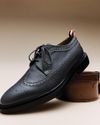
FOR AS LONG AS THERE HAS BEEN A UNITED STATES OF AMERica, its highest-ranked somebodies have been white, educated men of means. The nobodies have changed across the ages, but for longer than there has been a U.S. of A., the somebodies have conspired Black people into the ranks of nobodies. Black people have opposed that oppression since they were stolen to these shores, have achieved remarkable gains given the dominion of those oppressors. And those gains were most prolific in the 12-year period following the ratification of the 13th Amendment.
Fostering unrivaled Black progress at the time of Reconstruction, Congress created the Freedmen's Bureau (1865), whose role included affording Black people federal protection in the former Confederate states, border states, and Washington, D. C., and managing labor contracts between freedmen and former enslavers. In the radical political shift of Reconstruction, Black men gained their suffrage and the right to serve as elected officials (according to historian Eric Foner's Freedom's Lawmakers: A Directory of Black Officeholders During Reconstruction, more than 1,500 Black people took office in the South during that time), as well as the right to bear arms and own property. Despite the ineffectualness of efforts including the Southern Homestead Act of 1866 and General W. T. Sherman's Special Field Order 15 (source of the famed 40 acres and a mule), Black people still managed to buy 16 million acres of farmland by 1910. One study notes that more than 3,000 Black people owned businesses in the upper South by 1870. Reconstruction begot the first HBCU in the South and included the guarantees granted by the ephemeral Civil Rights Act of 1875: access to public schools, public transport, churches, and theaters and the right to serve as jurors and have lawsuits tried in federal courts.
This story is from the October - November 2023 edition of Esquire US.
Start your 7-day Magzter GOLD free trial to access thousands of curated premium stories, and 9,000+ magazines and newspapers.
Already a subscriber ? Sign In
This story is from the October - November 2023 edition of Esquire US.
Start your 7-day Magzter GOLD free trial to access thousands of curated premium stories, and 9,000+ magazines and newspapers.
Already a subscriber? Sign In

this charming man
Drew Starkey's performance in the Oscar hopeful Queer has Hollywood buzzing. He's also fashion's latest \"it\" boy and an incredible dinner companion. What is it about this guy?

what i've learned
I TAKE THINGS in stride. Maybe a lot of it is maturity. When I was a lot younger, in my late twenties, I was a tyrant.

the book of denzed
He has lived a big life. Tough streets, close calls, a wife of forty-one years, four kids, fifty movies, two Oscars, three Equalizers...all by the grace of God. For the first time on the occasion of Gladiator II, one of the biggest films of his epic career, and his approaching seventieth birthday the man himself breaks it all down, in his own words, to the moments that mattered and the experiences that made him. He has lived a big life, but Denzel Washington ain't done yet.

The Best New Restaurants in America 2024
THE OTHER DAY MY SON JASPER ASKED ME WHAT sounded like a simple question: \"Dad,\" he said, \"what is American food?\"

THE RISE AND RISE OF JANNIK SINNER
The world's number-one tennis player is winning MAJORS and dominating HIS rivals. Now comes the HARD PART.

ALL MONEY AIN'T GOOD MONEY
The current exponential proliferation of legal gambling preys on Black and brown people in unseen ways

DEAR FAMILY
Could my brother have made it any more obvious that he needed our help?

CORD CURRICULUM
You don't need to look like a rumpled college professor in your corduroys. The secret is picking the right pair.

Brogue Squadron
On the hunt for a dress shoe that doesn't feel too, well, dressy? Look no further.

THE G.O.A.T. OF CASHMERE
Why Loro Piana's take on luxury feels so right for right now